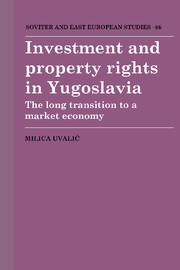Book contents
- Frontmatter
- Contents
- List of figures
- List of tables
- Preface and acknowledgements
- Introduction
- Part I The institutional and theoretical framework
- Part II Empirical evidence on the nature of the Yugoslav system
- Part III Pressure for more radical reforms in Yugoslavia
- Notes
- List of references
- Index
- Series list
- Frontmatter
- Contents
- List of figures
- List of tables
- Preface and acknowledgements
- Introduction
- Part I The institutional and theoretical framework
- Part II Empirical evidence on the nature of the Yugoslav system
- Part III Pressure for more radical reforms in Yugoslavia
- Notes
- List of references
- Index
- Series list
Summary
Over the past forty years Yugoslavia has been trying to develop its own model of socialism based on workers' self-management, decentralization, social ownership and increasing reliance on the market. These characteristics of the Yugoslav economic system have led many scholars to consider Yugoslavia to be very different from other socialist economies, frequently ascribing, in line with the theoretical literature on the labour-managed firm, economic inefficiency of the Yugoslav economy to the specific features of its economic system.
At the same time, however, until 1989 Yugoslavia remained a socialist economy characterized by many of the systemic features (and problems) of a traditional centrally planned economy. Although in Yugoslavia some of the typical priority objectives of centrally planned economies have been abandoned – such as full employment and price stability – along with many of the traditional centralized institutions, other fundamental socialist goals have been retained, including the commitment to non-private property, planning, egalitarianism, and solidarity.
The intention of this book is to evaluate the impact of such ‘dualism’ – self-management and increasing use of the market on the one hand, and socialist features on the other – on the nature of the Yugoslav system, by focusing on the specific field of investment. The period examined is primarily post-1966, since it is with the reforms of the 1960s that substantial institutional changes were introduced into the economy, in particular in the field of investment.
The book is divided into three main parts. After these introductory remarks, the first part describes the institutional setting and presents the theoretical framework necessary for understanding Yugoslav investment behaviour.
- Type
- Chapter
- Information
- Investment and Property Rights in YugoslaviaThe Long Transition to a Market Economy, pp. 1 - 2Publisher: Cambridge University PressPrint publication year: 1992

